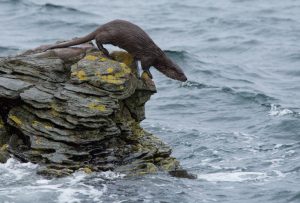 With the New Year upon us why not think about setting yourself some wildlife targets for 2017? Whether you are interested in wildflowers, mammals, insects or birds there is always something different to see. As far as mammals are concerned one target could be to see all the different species of deer in the Highlands which is not too difficult as there are only five species if you exclude muntjac. There were several records, almost certainly correct, for muntjac some years ago when a pair were deliberately released near Beauly but there have been none since. Fallow deer is, perhaps, a doubtful one as the only current records seems to be of two herds in deer parks. One of these is just north of Inverness and the other long established one at Berriedale way up on the east coast. The one at Berriedale is unusual as they are all white deer. Fortunately they can be seen from the road so there is no question about permission for access. As for three of the other ones, red, sika and roe deer, they are virtually common in all part of the Highlands. The other deer is the very impressive reindeer that can be seen on the open hill in the Cairngorms east of Aviemore and close to at the Reindeer Centre nearby.
With the New Year upon us why not think about setting yourself some wildlife targets for 2017? Whether you are interested in wildflowers, mammals, insects or birds there is always something different to see. As far as mammals are concerned one target could be to see all the different species of deer in the Highlands which is not too difficult as there are only five species if you exclude muntjac. There were several records, almost certainly correct, for muntjac some years ago when a pair were deliberately released near Beauly but there have been none since. Fallow deer is, perhaps, a doubtful one as the only current records seems to be of two herds in deer parks. One of these is just north of Inverness and the other long established one at Berriedale way up on the east coast. The one at Berriedale is unusual as they are all white deer. Fortunately they can be seen from the road so there is no question about permission for access. As for three of the other ones, red, sika and roe deer, they are virtually common in all part of the Highlands. The other deer is the very impressive reindeer that can be seen on the open hill in the Cairngorms east of Aviemore and close to at the Reindeer Centre nearby.
If it is mammals you are interested in the one target and a real challenge would be to see an otter. These are quite widespread in the Highlands although commoner on the west coast. The photograph was taken on the west coast near Little Loch Broom and the otter is hunting and is just about to dive into the sea. In contrast they have been seen on the River Ness actually in Inverness, along the coast at Ethie on the Black Isle, and many of the rivers and lochans. These are often brief and fleeting glances at the most and another good example is the reporter on this newspaper who was glancing out of his office window at the firth below when as otter swam past. However, to see an otter for any length of time is another matter as they can be secretive and are disturbed very easily. Some books say that they are nocturnal but this is just not the case as I have seen them very active on the River Nairn and nearby lochs in the middle of the day. The best thing to do is to first establish that otters are in the areas and the best way to do this if to look for the droppings. These are left on prominent rocks in or on the side of a river or large burn. This will tell a male – called a dog – or female – called a bitch – that the territory is occupied so clear off. If the fresh droppings indicate otters then choose a viewpoint looking along a stretch of river or burn and just sit there as long as you can. If you are lucky you will see an otter behaving naturally.
There are other possible wildlife targets such as butterflies and one that would be worth looking for is the painted lady as its presence is so unpredictable as it is a migrant from Africa. The numbers vary each year but a good place to see them is in your garden providing you have been planning to have nectar sources such as Buddleias and Sedums. Now is the time to start planning for such nectar sources, and many others, so that when the summer comes butterflies will be faced with an abundance of food. However when butterflies are around do not do as I do which is to have an occasional glance at the garden and the plants. Take a chair out there and just sit for a long while and watch for the various butterflies and those elusive painted ladies. In contrast why not find sites to look for ten species of dragonflies over the summer. One good place is Loch Bran near Foyers and others include Glen Affric and the west end of Loch Maree. Then again another good target would be to see all the wild orchids growing in the Highlands as some of these are rare whilst others, such as the small white orchid, are difficult to find as they vary in number each year and are very inconspicuous. One aspect about such challenges is that they are so enjoyable and make you learn more about wildlife around you. The more you know about wildlife the more you enjoy it.
